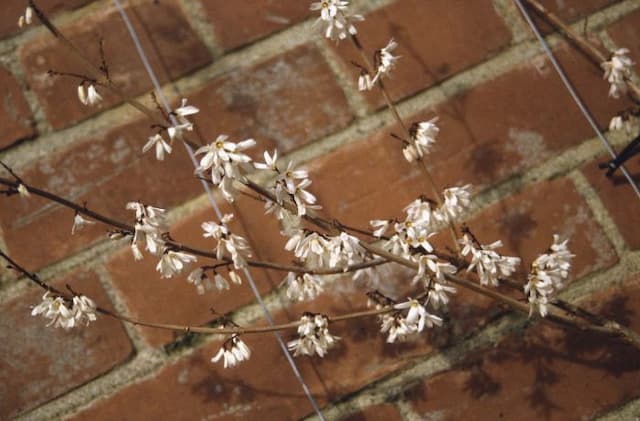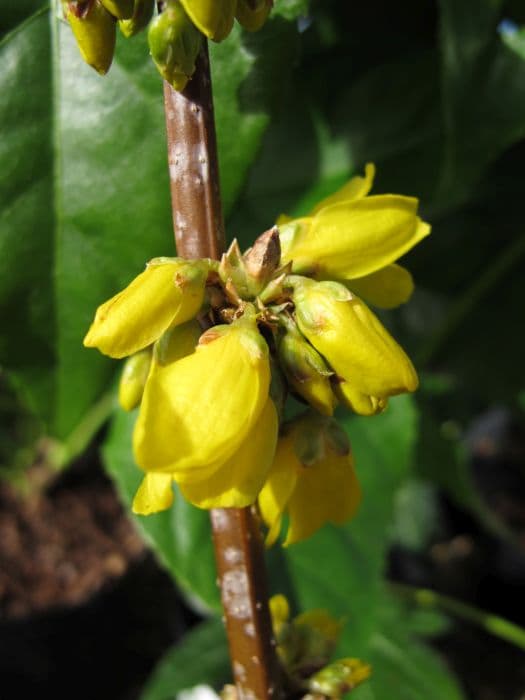Weeping forsythia Forsythia suspensa

ABOUT
Forsythia suspensa, commonly known as weeping forsythia, is a flowering deciduous shrub known for its eye-catching yellow blooms. The plant has long, arching branches that give it a graceful, weeping habit. In the early spring, the branches are adorned with vibrant yellow flowers that cover the plant before the leaves emerge, creating a spectacular display of color. These flowers are bell-shaped and grow in clusters, bringing a cheerful sight after the winter months. The leaves of weeping forsythia appear after the flowering period and are medium to dark green. They are simple leaves with a slightly serrated edge and can have an ovate to lanceolate shape, meaning they are egg-shaped, tapering to a point at the end. In fall, the foliage may turn to shades of yellow or sometimes purplish before dropping. The stems of the plant are slender, and newer growth has a green to yellow-green color, which becomes woody and brown as it matures. As the shrub ages, it can develop a thick, rugged look with the older branches maintaining a rough texture. Weeping forsythia is often used as an ornamental plant in gardens and landscapes for its burst of early spring flowers and attractive form. It can serve as a focal point when in bloom or be used in mixed borders, as a hedge, or even a standalone specimen. The plant can also be pruned to maintain a desired shape or to promote more vigorous flowering. In summary, weeping forsythia is characterized by its weeping branches, the bright yellow blooms that precede the foliage, and the green leaves that follow the flowering season. It has a natural elegance and charm that enhances garden aesthetics, especially in the springtime.
About this plant
 Names
NamesFamily
Oleaceae
Synonyms
Weeping Forsythia, Golden Bell, Lian Qiao
Common names
Forsythia fortunei, Forsythia suspensa var. fortunei, Forsythia suspensa var. sieboldii, Forsythia suspensa f. atrocaulis, Forsythia suspensa f. fortunei.
 Toxicity
ToxicityTo humans
Weeping forsythia is not commonly known to be toxic to humans. However, as with any plant, individual allergies or sensitivities could potentially cause a reaction, so it is generally advisable to avoid ingesting parts of ornamental plants without thorough expert guidance. There are no well-documented cases of poisoning from weeping forsythia in humans, and it is not typically considered dangerous.
To pets
Weeping forsythia is not commonly known to be toxic to pets such as cats and dogs. The plant is not listed on common toxic plant databases for pets. While it is not considered highly toxic, ingestion of non-food items by pets should be avoided, as it may cause gastrointestinal upset or an individual allergic reaction. If a pet ingests a large quantity of weeping forsythia or shows signs of illness, it's advisable to contact a veterinarian.
 Characteristics
CharacteristicsLife cycle
Perennials
Foliage type
Deciduous
Color of leaves
Green
Flower color
Yellow
Height
2-10 feet (0.6-3 meters)
Spread
2-10 feet (0.6-3 meters)
Plant type
Shrub
Hardiness zones
5-8
Native area
China
Benefits
 General Benefits
General Benefits- Ornamental Value: Forsythia suspensa, commonly known as weeping forsythia, is widely appreciated for its bright yellow flowers that bloom in early spring, providing a vivid and cheerful display in gardens and landscapes.
- Early Pollinator Support: This plant offers an early source of nectar for bees and other pollinators emerging in the spring, helping to support the local ecosystem.
- Erosion Control: Weeping forsythia has a robust root system that can help stabilize soil and prevent erosion on slopes and banks.
- Screening Plant: Due to its size and dense foliage, forsythia can be used as a natural screen or hedge, providing privacy and reducing noise pollution.
- Low Maintenance: Forsythia is known for being hardy and requiring minimal upkeep once established, making it an ideal choice for gardeners seeking low-maintenance plants.
- Wildlife Habitat: The dense branches of forsythia can provide shelter and nesting sites for birds and other small animals.
- Seasonal Interest: With its bright blooms in the spring and sometimes colorful foliage in the fall, forsythia adds year-round interest to the landscape.
 Medical Properties
Medical Properties- Anti-inflammatory: Forsythia suspensa is used in traditional medicine to reduce inflammation.
- Antibacterial: Compounds in the plant exhibit antibacterial effects.
- Antiviral: It has been used to fight certain viruses.
- Laxative: The fruit is sometimes used to alleviate constipation.
- Diuretic: The plant is considered to help increase the passage of urine.
- Antipyretic: Forsythia suspensa has been traditionally used to reduce fevers.
- Hepatoprotective: There are claims of its ability to protect the liver.
- Cardiovascular health: It may have beneficial effects on heart health.
- Anti-tumor: Some research suggests it could have anti-cancer properties.
 Air-purifying Qualities
Air-purifying QualitiesThis plant is not specifically known for air purifying qualities.
 Other Uses
Other Uses- Forsythia suspensa is often used as a landscaping plant due to its vibrant yellow flowers that add aesthetic value to gardens and parks, especially in the early spring when the blooms emerge before the leaves.
- Its fast-growing, dense foliage makes Forsythia an excellent choice for privacy hedges or living fences, providing a natural barrier that can be pruned to the desired shape and size.
- The long, straight stems of Forsythia are frequently utilized in floral arrangements and as a natural decor element, both fresh and dried, due to their durability and distinctive flowering.
- Gardeners use Forsythia as an indicator plant to signal the ideal time for pruning other early bloomers; when Forsythia starts to flower, it's time to trim certain roses and fruit trees.
- The plant can be used in erosion control efforts as its root system helps to stabilize soil on slopes and embankments, preventing the washout of fertile topsoil.
- Forsythia branches are sometimes used in the art of bonsai, with enthusiasts shaping them into miniature tree forms through careful pruning and wiring techniques.
- In craft projects, Forsythia branches are often incorporated into wreaths and other decorative items for a touch of natural beauty and a symbol of spring renewal.
- Some textile artists dye fabrics using the flowers and leaves of Forsythia to create soft yellows and greens, utilizing the plant's natural pigments.
- Beekeepers value Forsythia as an early source of pollen for bees, helping to support the health of the hive when other food sources are scarce.
- In some cultures, Forsythia branches are brought indoors in late winter and forced to bloom as a traditional way to hasten the arrival of spring, known as "Forsythia magic."
Interesting Facts
 Feng Shui
Feng ShuiThe Forsythia is not used in Feng Shui practice.
 Zodiac Sign Compitability
Zodiac Sign CompitabilityThe Forsythia is not used in astrology practice.
 Plant Symbolism
Plant Symbolism- Anticipation: Forsythia, often being one of the first plants to bloom as winter ends, symbolizes anticipation and the arrival of spring.
- Renewal: The bright yellow flowers are associated with the renewal and vitality that come with the changing seasons.
- Joy and Happiness: The vibrant color of forsythia is commonly linked to feelings of joy, happiness, and the positive energy of nature’s reawakening.
 Water
WaterWeeping Forsythia should be watered thoroughly, deeply saturating the soil around the root zone. Early morning is the best time to water to reduce evaporation and allow leaves to dry out during the day. During active growth in spring and summer, watering once a week with about 1 to 1.5 gallons of water should suffice. In the fall and cooler months, reduce watering to every two weeks or less, depending on the weather and soil moisture, but always allowing the soil to dry out between waterings.
 Light
LightWeeping Forsythia thrives in full sun, where it can receive at least six hours of direct sunlight daily. The plant can also tolerate partial shade, but flowering may be reduced. For optimal growth and bloom, place the plant in a spot that is exposed to bright, unfiltered sunlight all day long.
 Temperature
TemperatureWeeping Forsythia is hardy and can withstand a range of temperatures once established. The plant can survive in temperatures as low as 0 degrees Fahrenheit and as high as 80 degrees Fahrenheit. Ideally, it prefers the moderate temperatures of spring and fall and will flower best when the winter has typical cold periods.
 Pruning
PruningPrune Weeping Forsythia after it finishes blooming in the spring to help maintain its shape and encourage vigorous growth for the next season. Remove any dead or damaged branches, thin out crowded areas to improve air circulation, and trim back as needed to control size. It's best to prune annually, as this plant blooms on old wood; pruning at the correct time ensures flowering for the following year.
 Cleaning
CleaningAs needed
 Soil
SoilWeeping Forsythia thrives in well-draining soil that is rich in organic matter, with an optimum pH range between 6.0 and 7.5. A good soil mix can consist of equal parts garden soil, peat moss or compost, and perlite or sand to ensure adequate drainage.
 Repotting
RepottingWeeping Forsythia should be repotted every 2 to 3 years. Young plants may need to be repotted more frequently if they outgrow their pots, while mature plants can be repotted less often.
 Humidity & Misting
Humidity & MistingWeeping Forsythia prefers average to high humidity levels but is quite adaptable. It typically thrives in the humidity levels found in most outdoor environments without needing any special attention.
 Suitable locations
Suitable locationsIndoor
Ensure bright light; water when topsoil feels dry.
Outdoor
Plant in full sun to partial shade; water regularly.
Hardiness zone
5-8 USDA
 Life cycle
Life cycleForsythia suspensa, also known as Weeping Forsythia, begins its life cycle when seeds germinate in the soil, typically in the spring. The germinated seed develops into a seedling, which then grows into a young plant through the vegetative stage, characterized by the growth of leaves, stems, and roots. As the plant matures, it enters the flowering stage, usually in early spring, producing bright yellow flowers before the leaves fully develop. Following pollination, often facilitated by insects, the plant produces fruit in the form of capsules that contain seeds. These seeds are dispersed, often by animals or wind, completing the reproductive cycle. In winter, Forsythia suspensa becomes dormant, with its above-ground parts dying back, but it will rejuvenate from its root system come the next spring.
 Propogation
PropogationPropogation time
Spring
The most common method for propagating Forsythia suspensa, commonly known as weeping forsythia, is through softwood cuttings. This process usually takes place during late spring or early summer when the plant's new growth is mature enough yet still pliable. Gardeners typically cut a 4 to 6-inch (about 10 to 15 cm) section of the stem, just below a leaf node, ensuring a few leaves remain on the cutting to facilitate photosynthesis. The bottom cut is made at an angle to increase the surface area for rooting. After removing the bottom leaves, the cutting is often dipped in rooting hormone to expedite root growth before it is placed in a well-draining potting mix. Maintaining a humid environment by covering the pot with a plastic bag and keeping it in indirect light encourages rooting. Once established with a strong root system, usually after a few weeks, the new forsythia plant is ready to be transplanted outdoors.


![Forsythia [Marée d'Or]](/_next/image?url=https%3A%2F%2Fplants-admin.emdemapps.com%2Fimages%2Fplants%2F%2Fimages%2F604b5d7568293.png&w=640&q=75)






